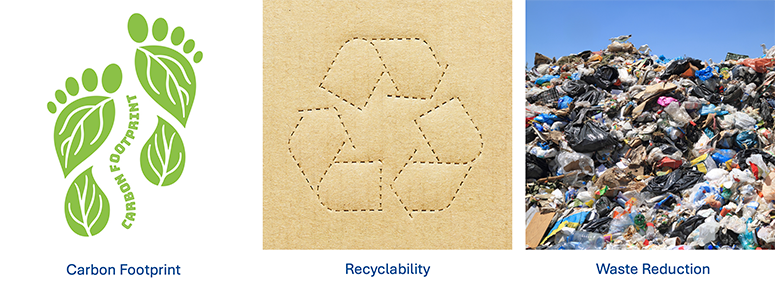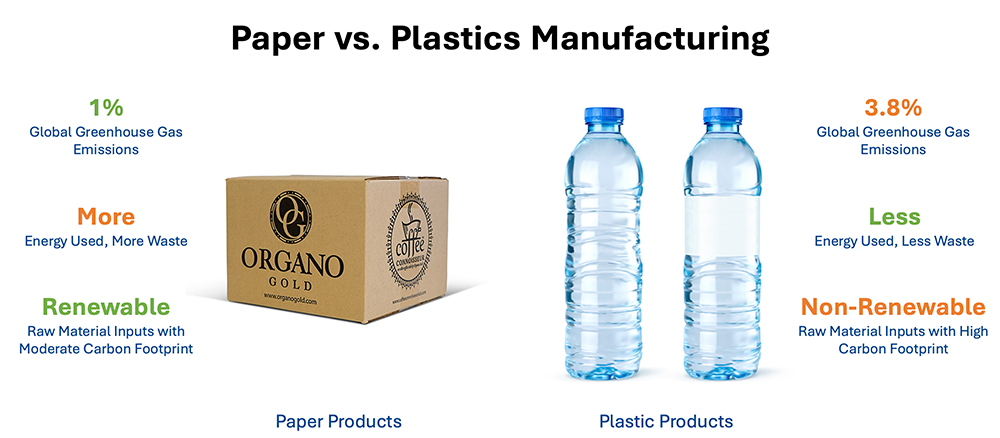What is Sustainable Packaging?
Sustainable Packaging: What is it?
To define sustainable packaging, companies need to understand the trade-offs across carbon footprint, recyclability, and waste reduction.
In this article we will discuss four considerations when evaluating sustainable packaging options, including:
- The recyclability of the packaging materials
- The recycled content that the packaging is made of
- The carbon footprint of the packaging raw materials and manufacturing process
- The sustainability of the manufacturing practices used to make the packaging

Packaging Recyclability
Packaging recyclability is the rate at which the material can be recycled and then reused, after its initial use. Aspects of recyclability can be the choice of materials, modularity of the packaging, or the infrastructure available to properly recycle the product.
Recycled Content
Recycled content in packaging can be derived from post-industrial or post-consumer waste. Post-industrial is often material trim or set-up waste collected in the manufacturing process and recycled. Post-consumer refers to goods recycled after reaching the end consumer. By using one of these two forms of waste as a manufacturing input, you can promote that your packaging is manufactured with recycled content.
Carbon Footprint
The carbon footprint of a product can be found by understanding and quantifying the energy intensity of designing, manufacturing, and shipping one package, in terms of carbon dioxide equivalent or CO2e, meaning the approximate metric tons of carbon dioxide that a process creates.
According to McKinsey, to better understand the true carbon footprint of packaging, it is important to take an end-to-end view of the value chain and apply a systematic approach to quantifying emissions profiles. This means being aware of the raw input materials and the disposal/recycle infrastructure availability to have end-to-end awareness of packaging’s carbon footprint.
To better understand this in practice, let’s look at the manufacturing impact of paper vs plastics:
The creation of plastic accounts for 3.8% of global greenhouse gas emissions. However, the global carbon footprint of the paper and cardboard industry is relatively low – only around 1% – due to manufacturers using renewable energy sources such as biomass, biogas, and hydroelectricity. In many cases, paper and cardboard factories use their waste products as a source of fuel.

Plastic is made via a more efficient process that requires around 40% less energy than cardboard while also producing less waste. On face value, plastic vs cardboard packaging appears to have a lower carbon footprint – but we also need to look at what happens before and after the plastic is made.
Plastic comes primarily from fossil fuels (crude oil and natural gas), which carry a significant carbon footprint due to their extraction, refinement, and transportation demands. In addition, most of the plastic is not recycled and ends up in landfill or waterways, or in many cases – industrial incinerators.
In summary, plastic is more efficient to manufacture than cardboard and produces less waste during the process. However, much of plastic’s carbon footprint comes from the extraction and transport of raw materials – namely oil and gas – and it produces significantly higher emissions when incinerated – which is common.
Cardboard manufacturing uses a high percentage of recycled materials, and the process is often powered via renewable energy. Combine these factors with a high end-of-use recycling rate, and cardboard maintains a considerably lower carbon footprint.
Sustainable Manufacturing Practices
When you and your company are discussing your sustainability plans and sourcing options, knowing which packaging suppliers can offer the most sustainable options is difficult, but we want to share some factors that will help in that decision-making process. Sustainable manufacturing practices, according to the Organization for Economic Co-operation and Development (OECD), can be bucketed into the following categories: The proximity of manufacturing to the end customer base, reducing inputs in production, improving the efficiency of the facility operations (i.e. energy use, water use, and mechanical processes), and improving products to reduce impact in use at the end of life, by creating product circularity.
Subscribe
Share this post
Similar Articles

How to Get Started with Sustainable Packaging
Learn how to develop effective sustainable packaging solutions by leveraging your custom packaging s …

Environmental Offsets: A Path to Greening Your Packaging Business
Want to make your packaging more eco-friendly? Explore how environmental offset services like PrintR …

Exploring Alternatives to Foam Protective Packaging
Supply chain limitations are increasing the need for custom fabricated foam alternatives. Explore PE …
